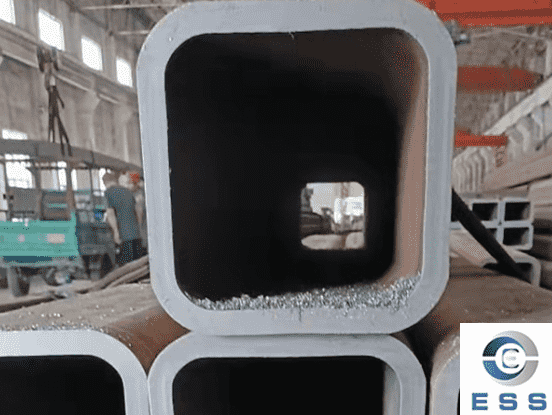The tubes within the condenser are the primary method of heat exchange. When condenser tubes become dirty or scaled, efficiency decreases and costs increase. It is expensive to run a chiller, and when efficiency decreases, costs increase dramatically, and other system components also wear out. Tube scaling typically includes sludge, slime, and mud. When scale deposits are present, the efficiency decreases even more.
What is the best method for heat exchanger tube cleaning?
The best heat exchanger tube cleaning method depends on the type of deposits present. We recommend a rotary tube cleaning system that includes shaft and brush technology with integrated flushing for soft to medium organic deposits such as mud, silt, algae, etc. This technology quickly removes and flushes deposits from the tube walls. If hard deposits such as scale, magnesium, and struvite are present, a chemical descaling agent is recommended. In extreme cases, a combination of the two methods is required.
1.High-pressure water jet cleaning method
High-pressure water jetting is a more traditional tube cleaning method, and it is just what the name suggests. The extremely high PSI of water ejected from the nozzle can wash away debris and dirt.
The problem with high-pressure water jetting is that it is slower than other competing processes. High pressure also creates a significant safety hazard. The process is slower because the gun is pushed down and back along the entire length of the tube. The action of the gun prolongs the cleaning time compared to other cleaning systems. On top of this, the operator is exposed to the hazards posed by the water jet itself. In addition, high-pressure water jetting consumes more water than competing systems, and the recovery/disposal of this cleaning water increases the overall cost of the project.
Cleaning Principle: This pipe cleaning method uses a pressurized stream of water to shoot projectiles through the pipe, removing dirt as it passes. Water pressure is typically between 350 and 450 PSI. This propels the pipe cleaner at a speed of about 15 feet per second and ensures the best surface cleaning results.
2.Mechanical Pipe Cleaning Methods
Mechanical pipe cleaning uses projectiles rather than water jets to clean the pipe. This projectile-based methodCondenser Tube Cleaning has become increasingly popular as maintenance technology has advanced and has replaced high-pressure water jets due to its cost-saving capabilities and improved safety.
The gist of mechanical pipe cleaning is that a pipe cleaner (which can be made of plastic, metal, or nylon brushes) is fired into the heat exchanger pipes. While quickly moving through the pipes, the cleaning projectiles scrape and blow through any dirt or debris inside the pipes.
The type of cleaner you use depends on the type and hardness of the dirt in the pipes. Mechanical pipe cleaning methods not only do a good job of removing debris, but they are also faster and cheaper than traditional methods. This includes the high-pressure water jetting mentioned above. The main reason for the cost savings is the high speed of pipe cleaning. Typically, a team of three to four pipe cleaners can clean 450-500 pipes per hour. This rate is much faster than competing methods such as high-pressure water jetting.
How it works: The air and water system basically uses air pressure between 80 and 120 PSI to shoot the pipe cleaner through the pipe at a speed of at least 30 feet per second. The water component removes airborne debris in the form of flushing the pipe during the cleaning process, rather than acting as a propulsion.
3.Chemical cleaning
Chemical cleaning of heat exchangers uses chemical cleaning fluids to cause chemical changes, decomposing, removing or eliminating scale and other deposits on the surface of the heat exchanger. Chemical cleaning does not require disassembly and assembly of the heat exchanger, which simplifies the entire cleaning process and reduces the labor intensity of cleaning. The disadvantage is that if a poor chemical cleaning solution is selected, the growth matrix from which the raw materials are removed will be affected and damaged.
4.Ultrasonic cleaning
It mainly uses ultrasonic sound fields to process fluid mechanics, so that the shell-forming materials of fluid mechanics under the action of ultrasonic fields cause a series of changes in their physical shape and chemical properties, causing them to disperse, break, loosen, etc.
5.Hot cleaning
Cleaning heat exchangers contaminated by (partial) organic pollutants such as coke, plastics, oils, paints, rubber, food, etc. is still a major problem for many companies.
Parts cleaning is needed in all industrial sectors. Some people think it is a daily necessity; others think it is a side procedure during disasters, overhauls or shutdowns. Obviously it is just part of the game, but in any case, it should be done as quickly and as well as possible. In most cases, this is usually related to the available knowledge of known cleaning technologies.
How often should heat exchange tubes be cleaned?
Generally speaking, heat exchanger pipes in systems such as chillers are cleaned once a year. However, if the system is used more frequently or for heavy process cooling or heating applications, more frequent cleaning is recommended. System analysis and measurements such as pressure and pump pressure will help the operator determine if the pipe or cavity is narrowing and needs cleaning.
Summary
Heat exchange tubes are generally made of stainless steel pipes, which are welded pipes and seamless pipes. Through this article, you can understand why heat exchange tubes should be cleaned, the cleaning methods and principles of heat exchange tubes, and the cleaning cycle.













 Eastern Steel Manufacturing Co.,Ltd not only improve product production and sales services, but also provide additional value-added services. As long as you need, we can complete your specific needs together.
Eastern Steel Manufacturing Co.,Ltd not only improve product production and sales services, but also provide additional value-added services. As long as you need, we can complete your specific needs together.









